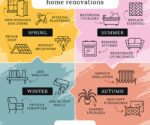Planning for future market trends

What products are selling and what items will be top-sellers in the future. These are key questions companies of all sizes should be asking believes Editor John Cowie.
Each year in boardrooms of window companies up and down the country, management teams will discuss strategic plans for the future. These discussions are not just reserved for the larger organisations. The locations maybe different, but installers and regional retailers are all going through the same thought processes and the same questions are being asked. What is currently selling well? Are there products that we should be selling? What is the competition up to? And importantly, what are the new products we should be looking at selling?
It doesn’t matter what size of organisation you are working in, the questions need to be answered if you are to maintain a healthy market position and a positive outlook for the future. You can often speak to people in the industry who will tell you there is ‘no white space left in the market’ and that the market has reached its saturation points. Fortunately, such people are few and far between and nowadays the majority of firms are focused on delivering the right products to the market. The only real constraints are issues related to finding the time to plan for the future. At the coalface of the market, installers and retailers are very adept at identifying the products that sell – the reality being that their livelihoods depend on getting it right!
As we approach the mid-way point of 2019, it’s worth taking a look back at the first 6 months of trading to see what products have been selling, what products homeowners are showing interest in and what products are being talked about as future star performers. It is widely acknowledged that it takes around 18 months for a product to pass from conception to being placed on the market for sale – a cycle that is constantly being performed by countless numbers of suppliers. Over recent years we have seen creations such as composite doors, bi-folding doors and roof lanterns change the physical composition of the marketplace. These products have been enhanced by innovative but subtle changes to locking mechanisms, extrusion profiles and manufacturing techniques. What installers and retailers are really interested in are the next big sellers. If we study trends over the last 6 months you will find growing market penetration for inline sliding doors and solid roof conservatories.
Demand for these two product types is being driven by increased consumer awareness facilitated by home interest media in the form of TV programmes and also by home & style editors. An interesting point was made recently by a major retailer who claimed that the highlighted new trends often detract from the fact that staple popular products like aluminium bi-folds remain top sellers. Often, homeowners are not aware of the product enhancements that are being brought to market, such as concealed and slimline hardware. There is a balancing act when it comes to trends; those for the trade and those for headline makers in the consumer environment.
What is clear is that large expansive and minimalistic creations are really in vogue at the moment. Frameless-style sliding doors and windows that maximise light are really grabbing people’s attention. These high-impact items are also being joined by fenestration products that are sympathetic to a property’s existing style. Flush-sash timber-look PVC-U windows are all the rage and are now gaining real market share. Additionally, with the rise of aluminium, we are seeing an influx of slim heritage-style products. Art deco and contemporary style properties are the perfect home for such products. In many locations, the modern-day replacement Crittal Windows are the perfect proposition for these styles of properties. When you study the early properties dominated by Crittal Windows, you would be hard pressed to beat their clean lines and symmetry. As with many housing trends, they are cyclical and attempt to re-create designs from previous periods. A good starting point when looking to the future is to look at the past. If you have the time, a flick through the excellent book ‘100 houses, 100 years’ should be inspiration enough to get you thinking about how we can enhance and improve former modernist creations.











